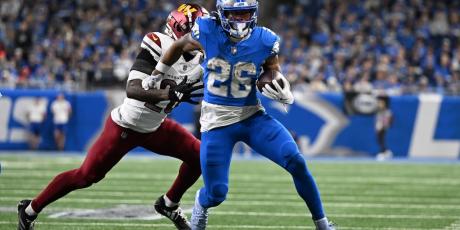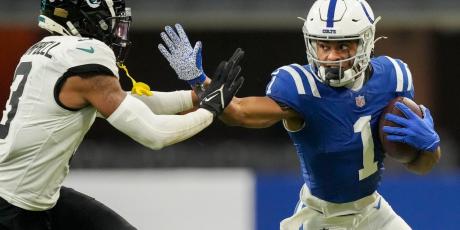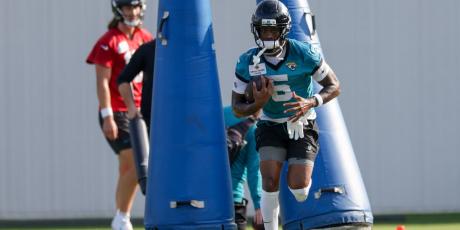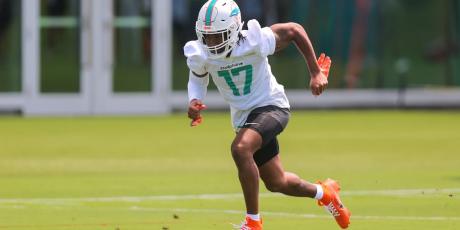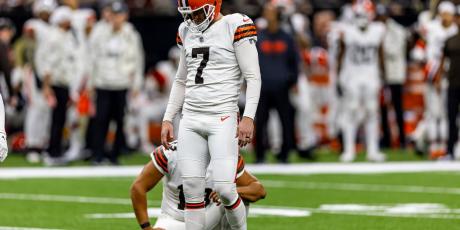Depth Chart Battle: Zack Moss or Devin Singletary?

Coming off of one of the pass-heaviest seasons we’ve seen from them (their highest neutral pass rate since at least 2006), the Buffalo Bills running back depth chart remains mostly unchanged, giving us some priors to work with when considering which piece of the backfield we want on our fantasy teams. While the pure percentage of plays that result in a pass attempt should regress at least a little bit, Devin Singletary and Zack Moss still have to deal with quarterback Josh Allen’s rushing prowess, particularly around the goal line.
Because of the passing game that heavily favors wide receivers over the running backs, and Allen’s propensity to gobble up goal-line touchdowns for himself, it’s important when we target this backfield that we come away with the right answer. Let’s dig into which option —and which draft capital price point— should return better fantasy value.
Other Profiles & Debates: Player Profiles | Player ADP Debates | Jonnu Smith vs. Hunter Henry | Jaguars WRs | Patriots RBs | Melvin Gordon vs Javonte Williams |
Zack Moss (Underdog ADP:107.2, RB34)
Coming out of Utah as a powerful —albeit stiff— interior rusher who used his strength and burst at the point of attack to accrue chunks of yardage through the heart of the defense, Zack Moss looked like he was going to add an element that was lacking in the Bills offense. Add to that bruising style a relatively large involvement in his college’s passing game (30+ targets in two separate seasons) and we had all the makings for a fantasy stud.
Moss saw the field plenty in Week 1, logging a decent 45% snap share but received nine rushes for 11 yards, with five of them going for zero or negative yardage. He did receive four targets in that game and turned one of them into a touchdown (on a broken play from inside the five-yard line), but it would end up being a season-high in targets right out of the gate, and he would not find paydirt through the air for the rest of the season. Moss went on to miss three games due to a foot injury shortly after the season opener and would proceed to soak up double-digit touches in just eight of his 13 games played (Singletary hit that number in 12-of-16 games).
Disregarding a Week 17 blowout win that Moss and Singletary both mostly ceded to third-stringer Antonio Williams, the rookie wrapped up his debut season with snap shares of 59%, 47%, and 49%, more or less splitting the workload right down the middle with his partner in crime. Moss ended up finishing the season having run 128 routes, nearly half the amount of Singletary (255), and received 18 targets, good for eighth on the team. That’s certainly a disappointment for any fantasy player who was under the presumption that he was going to wrest away the third-down role. What was decidedly not a disappointment was his usage as goal-line back; Moss matched Josh Allen’s team-leading rush attempts from inside the 10-yard line (15 apiece), converting four of them into touchdowns.
Zack Moss! It's a @buffalobills TD! @PresMoss2
📺: #NEvsBUF on CBS
📱: NFL app // Yahoo Sports app: https://t.co/VpbDsNEjOj pic.twitter.com/mg15cjE4g7— NFL (@NFL) November 1, 2020
Devin Singletary (Underdog ADP:147.7, RB46)
In his own rookie season of 2019, Singletary took a bit to get going, due mostly to a Week 2 injury that kept him out of action until Week 7 and due partially to the coaching staff’s insistence on keeping Frank Gore involved in the offensive gameplan. Whether that continued Gore involvement had anything to do with Singletary’s four fumbles in the back half of the season is now a moot point as he reduced those infractions to only once in 2020.
Outside of the fumbling issue/non-issue, the entirety of last season compared to 2019 was essentially the same when it came to the rushing game for Singletary; his expected points added (EPA) dropped from a marginal 0.01 per attempt to an equally marginal -0.04 per attempt, his yards per carry dropped from 5.1 to 4.4, broken tackles stayed the same (19) and his forced missed tackles dropped one, from 17-to-16. Where we saw improvement in his game, particularly as it pertains to fantasy scoring, was in the passing game, where his 29-194-2 stat line from his rookie season jumped to 38-269-0 as a sophomore.
All-in-all, Devin Singletary didn’t exactly rewrite the book on himself with last year’s performance, but if he is in the middle of a slow transformation into a passing-game specialist who can sniff 60-70 targets with occasional bursts of usage in the run game, we could be on to something for fantasy purposes.
Which One Should You Draft?
It would be the easiest answer to simply say “neither”, throw our hands up, and walk away from this depth chart. Yet, sometimes these are the precise situations we can derive the most fantasy value from. Moss and Singletary are currently going as an RB3 and an RB4 at the end of the eighth round and the beginning of the 13th round, respectively, and that gives us a lot of wiggle room when considering what kind of output we would need from that draft capital. Though our priority should be to find out if last year’s usage will continue through the 2021 season. When asked recently about exactly that, offensive coordinator Brian Daboll responded,
“Whoever’s back there is playing good. Let’s say you’re in a game and you just get a sense one guy’s got it going a little bit more than the other guy and that’s the guy you ride with a little bit. “
You’ve got to love a definitive answer like that. The dreaded “hot hand” approach quote is always good for a sigh and a temple rub. A more conclusive response came from Bills reporter Joe Buscaglia who mentioned not only that Moss “can take over the backfield in 2021 if he continues to improve, which could be a 60 to 70% snap player in the Bills’ case.” He also suggested there’s a possibility that Singletary becomes a weekly inactive. While it’s not the most likely scenario, the fact that it’s even a possibility should give us a pause.
Let’s say all of that pontification is simply smoke. We should take into account the fact that the Bills have targeted running backs on 20.4% (19th in NFL), 17.1% (25th), and 13.9% (28th) of their throws over the last three seasons, so even if Singletary can muster most of the targets out of the backfield, there is a ceiling to how many raw targets that will turn out to be. Last year very well could have been as high as that number can get.
The answer here is decidedly Zack Moss. He has the avenue to not only build upon his work near the end zone but can also shoulder more of the load in the passing game. His ceiling would be a running back who accounts for 60-to-70% of his backfield’s touches in a top-five offense. That’s good enough for me to pay for the 107th player off the board.


